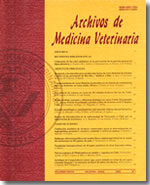A comparison of milk fatty acid profile among three different dairy production systems in Los Ríos District, Chile
Main Article Content
Abstract
The objective of this study was to compare three different dairy production systems in Los Ríos District, Chile, with regards to milk fatty acids profile. Nine representative farms were selected from a survey and classified into three systems: grazing (GS), mixed (MX) and total mixed ration (TMR). Bulk milk tank samples were monthly obtained during an 18-months period, and milk components and fatty acid analyses were conducted. The grazing and mixed systems had higher concentrations of n-3 fatty acids and rumenic acid, which was associated to higher pasture intakes. Milk from grazing and mixed systems had twice as much rumenic acid than milk from TMR system in late winter and spring. These results are coincident with previous studies showing higher concentrations of fatty acids beneficial to human health in milk from grazing cows.

